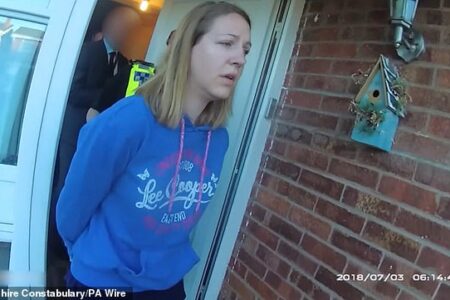The chance of eight babies dying in one year on the neonatal unit where Lucy Letby was killing infants was less than one per cent, an expert statistician said today.
Sir David Spiegelhalter, emeritus professor of statistics at Cambridge University, said he had recently analysed the number of deaths on the hospital’s neo-natal unit between 2010 and 2016.
He said that, up until 2015, when Letby began her killing spree, the number of deaths per year at the Countess of Chester Hospital was ‘surprisingly consistent.’
According to hospital data, there was one death in 2010, two in 2013, and three in 2011, 2012 and 2014. Sir David estimated the underlying average death rate to be 2.4 per year.
But the number of infant deaths jumped to eight in 2015 and there was another five in the first seven months of 2016.
In August 2023, Letby, 35, was convicted of murdering seven of these infants – five in 2015 and two in 2016.
Sir David told the Thirlwall Inquiry, which is investigating Letby’s crimes, that: ‘The probability of getting eight or more deaths in 2015, just by chance alone, I assess as 0.008…less than one per cent.’
He said the numbers ‘would be considered sufficient’ to trigger an investigation on a local level at the hospital, as occurred at the Countess, where clinicians, and later hospital chiefs, initiated a series of internal and external reviews into the spike in deaths.

In August 2023, Lucy Letby, 35, was convicted of murdering seven of these infants – five in 2015 and two in 2016

Sir David Spiegelhalter, emeritus professor of statistics at Cambridge University , said he had recently analysed the number of deaths on the hospital’s neo-natal unit between 2010 and 2016
But Sir David, who previously backed calls by the Royal Statistical Society for statistics to be ‘expertly analysed’ by the public inquiry, stressed they would not be considered ‘extreme enough’ for the Countess to be considered an ‘outlier.’
He explained that, of the 150 neo-natal units in the UK, he would expect ‘one signal of this magnitude’ in at least one hospital every year.
‘This is a surprising event in the Countess of Chester Hospital, but on a national level it is not very surprising at all, I would expect this to happen every year, somewhere,’ he added.
Sir David said analysis of data from MBRRACE-UK, the organisation that collects information on baby deaths from hospitals in the NHS, showed that the number of neo-natal deaths at the Countess in 2015 was more than 10 per cent higher than average, and up to 10 per cent higher the following year.
He said the hospital’s ‘crude’ neo-natal mortality rate of 2.96 per 1,000 babies, which equates to nine deaths, placed it ‘highest’ of 27 units in its tier – those units handling between 2,000 and 4,000 births a year.
But he also pointed out that Blackpool’s neo-natal unit also had a very similar level of 2.73, again adding: ‘It (Countess) was high but one would not call that an outlier.’
Sir David said the fact that different NHS data collection and computer systems in hospitals, GP surgeries and other healthcare settings were still unable to talk to each other was an ‘utter disaster’ for the UK.
But William Vineall, director of NHS Safety, Quality and Investigations, told the inquiry there was currently no plan to integrate them.
The former neo-natal nurse was convicted of murdering seven babies at the Countess of Chester Hospital during a 13-month killing spree, between June 2015 and June 2016
A sign outside the Countess of Chester Hospital in Chester where Letby worked
Letby was on duty, or had been working the shift prior, for 12 of 13 baby deaths that occurred at the Countess of Chester Hospital between March 2015 and July 2016
Screen grab taken from body worn camera footage issued by Cheshire Constabulary of the arrest of Lucy Letby
The civil servant, who has spent his entire 26-year career at the Department of Health, admitted that a policy document advising when a hospital should contact police if they had suspicions about a staff member causing deliberate harm had been ‘archived’ and was not available to bosses at the Countess in 2016, when concerns were raised about Letby.
But he insisted this should not have stopped hospital executives from calling police sooner.
‘I agree there wasn’t a memorandum of understanding that people could immediately turn to, but I don’t think that should have stopped people approaching the police,’ he said.
‘Our expectations of a decently operating organisation is that, if they had significant doubts about whether or not to go to the police, they should go to the police.’
Mr Vineall also told the inquiry the Government was currently considering appointing a national neo-natal safety champion for the NHS following the Letby case.
‘My understanding is that advice is going to go to ministers shortly,’ he added.


